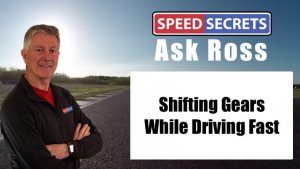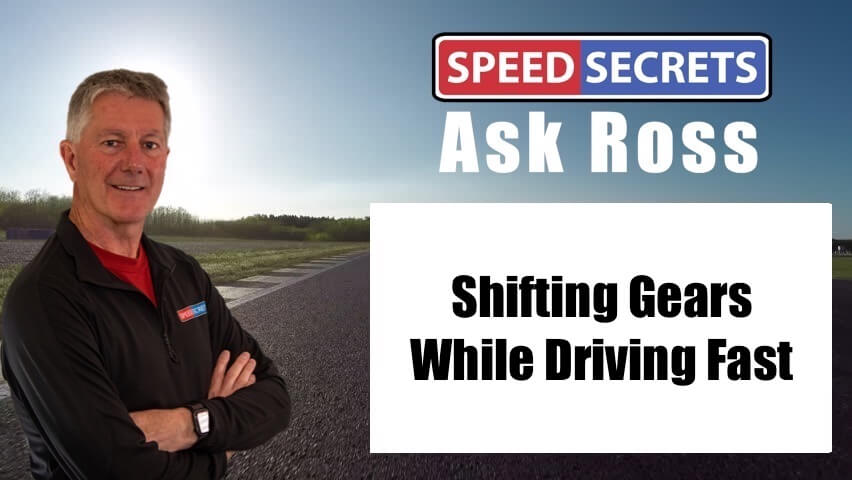 Q: “When I push hard, I tend to mistreat the gearbox to the extent that I have already damaged it or the engine on two occasions. This always happens when I’m under pressure. When I focus on managing the gearbox and try to preserve it, I’m consistently slower because I can’t reconcile this with driving in “attack” mode. Do you have any tips to help me drive as fast while managing the gearbox properly?”
Q: “When I push hard, I tend to mistreat the gearbox to the extent that I have already damaged it or the engine on two occasions. This always happens when I’m under pressure. When I focus on managing the gearbox and try to preserve it, I’m consistently slower because I can’t reconcile this with driving in “attack” mode. Do you have any tips to help me drive as fast while managing the gearbox properly?”
A: I know you know this, but smoothness is critical – most often more important than a fast shift. When you’re under pressure, it’s time to trigger a calm and composed demeanor, focusing on executing each shift smoothly and accurately.
To avoid missing any gear changes, you might try shifting slower and more deliberately. Be firm and positive with your shifts, as some gearbox failures have occurred by “babying it” too much, as well as from being too rough. I understand that being slightly slower can cost you lap time and maybe even a position, but how much does a missed shift cost? Think about the trade-offs, and consider that if the only way to stay in front of another car is by destroying gearboxes and engines… is that something you’re willing to do?
The job description for a race driver is drive the car to its limits, no more, no less. Your gearbox and engine have limits. Shifting too fast for either the gearbox or engine is no different than spinning off the track and crashing.
The appropriate timing for downshifting is crucial for maintaining the balance of the car and ensuring smooth transitions between gears. Here are some key points to consider:
- The purpose of downshifting is to get the car in the best gear for accelerating out of the upcoming corner, not for slowing the car Your brakes are for slowing the car down, and the engine is for accelerating.
- Ideally, you should time your downshifts throughout the brake zone, from the Begin-of-Braking (BoB) to the turn-in point. You want to have your final downshift completed by the time you turn into the corner.
- If you’re using the clutch on your downshifts, make sure you’re releasing it immediately after your throttle blip. If you keep the clutch in any longer, the engine revs (caused by your throttle blip) will have died down, and therefore the engine revs and the driving wheels speed will not match.
- If you’re using a sequential shifter, the blip of the throttle is simultaneous with the movement of the shifter. Focus on the timing and amount of your throttle blip.
- It’s also important to manage the timing of your downshifts. Try to get all of your downshifts completed prior to turning into corners. This helps to maintain the balance of the car and prevent spins.
- I like to think about downshifting this way: Brake… wait… downshift. It’s not brake and downshift. Wait as long as you can in the brake zone to begin downshifting, but always complete the last one just before turning into the corner. Yes, it can get busy sometimes, so maybe you want to skip gears when downshifting. For example, instead of a 5-4-3-2 brake and downshift, you could bypass shifting into 4th and 3rd and just shift into 2nd from 5th at the same point.
Remember that driving fast isn’t just about pushing hard. It’s also about managing your car effectively. If you can learn to manage your gearbox properly while also driving aggressively, you’ll be able to maintain your speed without causing damage to your car.
To remain calm while pushing hard, first practice mental imagery or visualization. Visualize yourself driving aggressively but staying calm. Replay this image in your mind until it becomes a norm for you.
Practice breathing exercises. Be aware of your breathing and program yourself to breathe in those intense driving situations. For example, deliberately exhale every time you begin braking or enter a fast freeway off-ramp. Practice this until it becomes a habit, one that you’ll use when on the track.
Relax your hands on the straights prior to the brake zones. Avoid gripping the steering wheel too tightly as this can increase tension. Remember to breathe fully to help you stay relaxed.
Use what I call a Pre-Planned Thought, or PPT. This is something that is easily recalled and emotionally positive for you. Use this thought to help you focus and/or re-focus during intense driving situations. An example is, “Eyes up, look ahead.” Whenever you say this, relax, breathe, and look far ahead. If you feel yourself beginning to tense up, or you notice yourself starting to push too hard, say this to trigger yourself calming down and timing your shifts perfectly. When shifting gears, you might use something like, “Calm, positive” to give you the right pacing for your gear changes.
Lastly, determine your optimum level of being “psyched.” Be aware of your emotions, tension, anxiety, nervousness, and energy. Find the level that results in your best performance and try to maintain that level when you’re driving aggressively.

